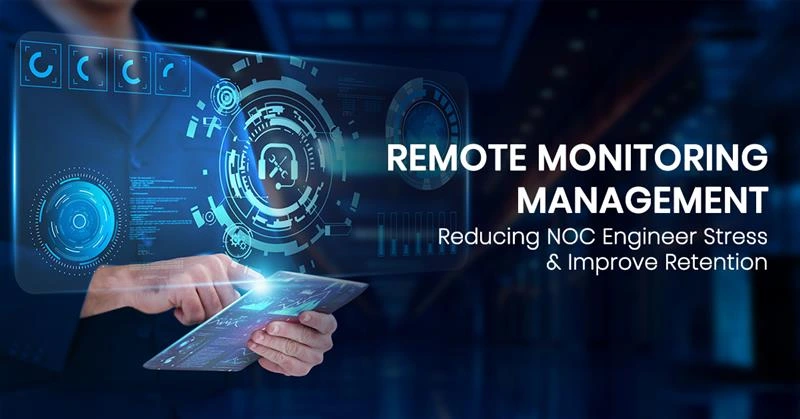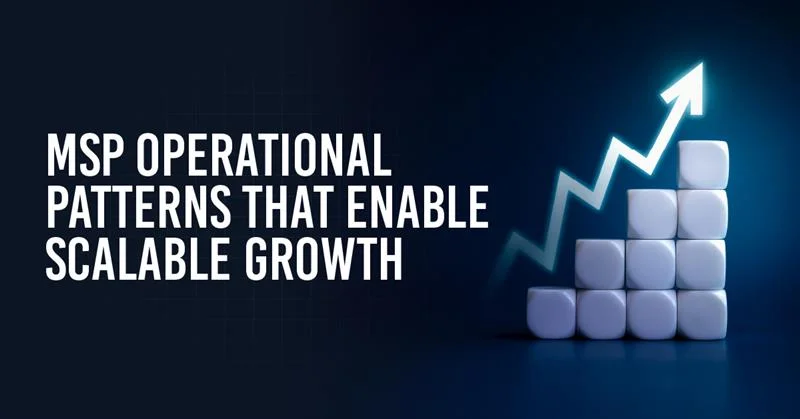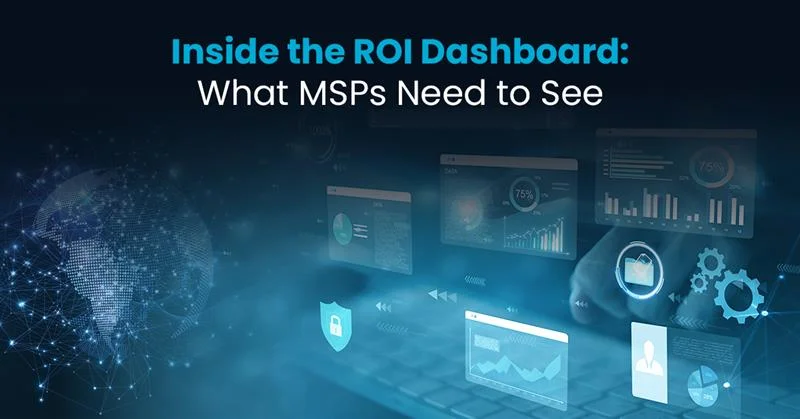Your Network Operations Center (NOC) engineers are the unsung heroes who put in a lot of overtime behind the scenes in the high-stakes world of IT infrastructure management. But at what price? Many teams are in an unsustainable condition because of the constant strain of alert management, unforeseen events, and the round-the-clock nature of NOC administration. The good news? The way NOC teams operate is being revolutionized by remote monitoring management (RMM) systems, which also significantly increase operational effectiveness and engineer well-being.
The Hidden Costs of NOC Engineer Stress
The toll of traditional NOC operations extends far beyond mere inconvenience—it represents a significant business risk with measurable impacts on your bottom line and team sustainability. Let’s examine the true costs behind the scenes.
Why Traditional NOC Monitoring Services Led to Burnout
Picture this: It’s 3 AM. Your NOC engineer’s phone buzzes with yet another alert – the fifth one tonight. Is it critical? Maybe. Is it a false positive? Possibly. Either way, sleep is interrupted, stress hormones spike, and tomorrow’s performance suffers.
This scenario plays out nightly in organizations relying on traditional NOC monitoring services. According to a recent CompTIA survey, 68% of NOC professionals report experiencing moderate to severe burnout, with alert fatigue cited as the primary culprit.
The effect on finances? Stumbling. The cost of replacing a single NOC engineer may range from 100 to 150 percent of their yearly compensation when you account for lost productivity, onboarding, training, and recruiting expenses. This adds up to hundreds of thousands of dollars in wasted spending per year for a mid-sized MSP.
Beyond the financial toll, consider these often-overlooked consequences of NOC team burnout:
- Decreased incident response quality: Fatigued engineers make 3x more errors in critical situations
- Knowledge loss: Each departing team member takes valuable institutional knowledge
- Customer satisfaction decline: Response times lengthen as teams operate understaffed
- Domino effect: Remaining team members shoulder heavier burdens, accelerating burnout cycles
Clearly, traditional approaches to NOC management aren’t sustainable. This is where remote monitoring management transforms the equation.
The Remote Monitoring Management Revolution
NOC operations have undergone a paradigm change with the transition from simple monitoring to intelligent management. This change involves more than simply new tools; it involves a fundamental rethinking of how technology infrastructure support operates in the complicated contexts of today.
How Modern RMM Solutions Transform NOC Management
The evolution of remote monitoring management technology has revolutionized how NOC teams operate. Rather than simply alerting engineers to potential issues, today’s sophisticated remote monitoring management platforms act as intelligent filters, automated first responders, and workflow optimizers.
Evolution from Basic 24×7 NOC Monitoring to Intelligent Systems
Early NOC monitoring services focused primarily on detecting and alerting – essentially creating digital alarm systems. While effective at identifying issues, these systems generated overwhelming alert volumes with little context or prioritization.
Modern remote monitoring management platforms represent a quantum leap forward. These systems don’t just detect issues – they analyze, correlate, contextualize, and often remediate problems automatically. The result? Your NOC engineers only engage with genuinely critical issues requiring human intervention.
Key Features of Advanced RMM Ticketing Systems
Today’s RMM ticketing systems incorporate several game-changing capabilities:
- Intelligent alert correlation: Connecting related events to identify root causes rather than symptoms
- Automated remediation workflows: Executing pre-approved fixes without human intervention
- Predictive analytics: Identifying potential failures before they occur
- Customizable escalation pathways: Ensuring the right issues reach the right engineers
- Knowledge integration: Linking alerts to solution documentation and historical resolutions
The Difference Between Traditional and AI-Enhanced NOC Service Desk Operations
Perhaps the biggest development in remote monitoring management technology is the use of artificial intelligence. AI-enhanced systems are constantly learning and adapting, whereas previous NOC service desk operations depended on static rules and thresholds.
For example: An AI-powered remote monitoring management system can automatically apply temporary suppression rules to minimize needless disruptions when it notices that some warnings frequently resolve themselves in a matter of minutes. Like this, proactive intervention is made possible by pattern recognition skills, which can see emerging problems before they reach conventional thresholds.
Stress Reduction Through Automation
Automation isn’t just about efficiency—it directly addresses the human cost of NOC operations by eliminating repetitive tasks and cognitive overload. These technological advances create breathing room for engineers to focus on meaningful work rather than endless alert triage.
Specific Ways Remote Monitoring Management Reduces Workload
The strategic implementation of remote monitoring management tools directly addresses the primary stressors affecting NOC engineers. Let’s explore exactly how these solutions transform daily operations.
Automated Triage in 24×7 NOC Monitoring Environments
In traditional 24×7 NOC monitoring setups, engineers must evaluate every alert, determining criticality and appropriate response. This constant decision-making leads to cognitive fatigue and decreased performance over time.
Modern remote monitoring management solutions implement automated triage processes that:
- Pre-categorize alerts based on historical patterns and current system state
- Apply machine learning to distinguish between normal variations and genuine issues
- Automatically resolve tier-1 issues without engineer intervention
- Provide enriched context when human involvement is required
Intelligent Alert Correlation and Noise Reduction
Alert storms – when multiple related failures trigger numerous simultaneous notifications – represent one of the most stressful aspects of NOC management. Advanced remote monitoring management platforms excel at correlating these events, presenting engineers with unified incidents rather than dozens of related alerts.
For example, when a core router fails, traditional systems might generate alerts for the router, connected switches, service unavailability, and performance degradation across multiple systems. Modern RMM platforms identify the root cause and suppress secondary alerts, presenting a single actionable incident rather than an overwhelming barrage of notifications.
MSP Remote Monitoring & Management Best Practices for Alert Threshold Configuration
Even the most sophisticated remote monitoring management solution requires thoughtful configuration. Leading MSPs implement these best practices for their remote monitoring management deployments:
- Baseline establishment: Determining normal performance patterns before setting thresholds
- Business-impact alignment: Configuring alert criticality based on actual service impact
- Regular threshold reviews: Quarterly analysis and adjustment of alerting parameters
- Graduated response models: Creating escalation paths appropriate to issue severity
- Maintenance windows: Temporarily adjusting thresholds during planned changes
By implementing these MSP remote monitoring management best practices, organizations typically reduce alert volumes by 40-60% while improving issue detection accuracy.
Implementation Strategies
Successful transformation requires more than just purchasing new technology—it demands thoughtful planning and execution. The following framework provides a tested approach to implementation that balances immediate wins with sustainable long-term results.
Building Your IT Support NOC Around Remote Monitoring Management
Successfully implementing remote monitoring management requires a strategic approach that balances technical capabilities with human factors. Here’s a proven framework:
Phased Implementation Approach for RMM Ticketing Systems
Rather than attempting a “big bang” deployment, successful organizations implement remote monitoring management in measured phases:
- Assessment & planning: Evaluate current pain points and establish baseline metrics
- Core monitoring implementation: Deploy fundamental RMM ticketing system capabilities
- Alert refinement: Tune thresholds and correlation rules to reduce noise
- Automation expansion: Gradually implement automated remediation workflows
- Advanced analytics integration: Leverage predictive capabilities and business intelligence
This phased approach allows NOC teams to adapt gradually while demonstrating incremental value throughout the implementation journey.
Training Your Team on New MSP Remote Monitoring & Management Tools
Technological transformation requires human adaptation. Effective training programs for MSP remote monitoring management implementations include:
- Conceptual education: Helping engineers understand the “why” behind the new approach
- Hands-on scenarios: Practical experience with the RMM ticketing system using realistic examples
- Continuous learning: Regular knowledge-sharing sessions about emerging capabilities
- Champion development: Identifying and empowering internal experts who can support peers
The Human Element: Beyond Technology
While technology provides powerful tools, lasting transformation depends on cultural and organizational changes that support engineer wellbeing. The most successful organizations recognize that people—not just systems—determine ultimate success in NOC operations.
Complementing Remote Monitoring Management with Culture Changes
While remote monitoring management technology provides the foundation for transformation, lasting improvements require cultural evolution. Forward-thinking IT support NOC leaders complement their technical investments with:
- Work-life boundary protection: Establishing clear expectations about after-hours responsibilities
- Wellness programs: Providing resources for stress management and mental health
- Recognition initiatives: Celebrating automation adoption and continuous improvement
- Career pathing: Creating advancement opportunities as NOC operations evolve
Remote monitoring management solutions work best when deployed within a culture that values both operational excellence and engineer wellbeing.
Future Trends in NOC Automation
The evolution of remote monitoring management continues at an accelerating pace, with emerging technologies poised to further transform how NOC teams operate. Understanding these trends helps organizations prepare for—and capitalize on—the next wave of innovation.
The Future of NOC Management with Advanced RMM
The evolution of remote monitoring management continues at a rapid pace. Leading organizations are already exploring these emerging capabilities:
AI and Machine Learning in Next-Generation NOC Monitoring Services
The application of artificial intelligence in NOC monitoring services is advancing rapidly. Next-generation capabilities include:
- Natural language processing: Allowing engineers to interact with monitoring systems conversationally
- Anomaly detection: Identifying unusual patterns without predefined thresholds
- Automated knowledge harvesting: Learning from successful resolutions to improve future responses
The integration of these technologies with remote monitoring management platforms will further reduce NOC engineer stress while improving operational outcomes.
Conclusion: The Competitive Advantage of Engineer Wellbeing
The transformation of NOC operations through remote monitoring management represents far more than a technological upgrade – it’s a fundamental reimagining of how infrastructure support operates. Organizations implementing these solutions report substantial benefits across operational, financial, and human dimensions.
By implementing modern remote monitoring management solutions, you can typically achieve:
- 50-70% reduction in alert fatigue
- 30-45% improvement in first-response times
- 25-40% decrease in engineer turnover
- Significant improvements in both customer and employee satisfaction
IT By Design’s specialized NOC services exemplify this transformative approach, addressing engineer burnout through purpose-built remote monitoring management solutions specifically designed to reduce alert fatigue. Their strategic workload distribution prevents engineer overwhelm while providing 24/7 coverage models that respect work-life balance. Moreover, their established career development pathways demonstrably improve NOC engineer retention, while proven processes eliminate repetitive, low-value tasks that drain engineer motivation.
For organizations still relying on legacy NOC monitoring approaches, the message is clear: modern remote monitoring management isn’t just a technological imperative – it’s a competitive necessity in attracting and retaining the talented engineers who form the backbone of your service delivery.
Your NOC engineers are dreaming of uninterrupted sleep, and your business deserves better results. Schedule a call today with us to turn those dreams into reality!








